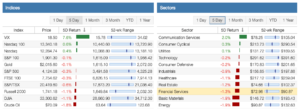
We all want to succeed in everything that we do, including investing in the stock market. Though I have no analytical data to back it up, I am convinced that most people will lose money in the stock market over their lifetime. So why do so few people succeed at investing? Could it be that an individual’s desire to succeed is a significant reason for their failure.
When discussing investing with various people, the conversation always follows a similar track. Usually, one of these:
- The person will mention a few stocks they did well with, then upon probing will admit overall they were down and they are looking for a new strategy to follow.
- The person will make a broad statement like ‘I’ve pulled everything out of the market it is just too risky.’ When pressed they admit to losing money not only this time but at other times when they abruptly exited the market.
- The person will concede that after significant losses they turned their money over to a professional.
Obviously, there are some success stories, and some of them are even believable. As the result of the 2008 market downturn, many people are more comfortable admitting losses because they know they are not alone. When you are losing 10% a year while the market is going up 20% a year, its harder to fess-up since you feel you are the only one losing money.
Why do so few people succeed at investing?
All the pieces to answer this question were presented above. People want to succeed, but don’t know how. So they try to follow someone (or something) that appears to be succeeding. A friend at work, or a talking head on a business show mentions a stock or strategy that is out performing the market, and the investor jumps on board. Unfortunately, he or she is late to the party and the run-up either stalls or reverses. Fearful of a greater loss the investor sells out and moves to the next hot stock or strategy. Eventually, they permanently exit the market or turn their money over to a professional that may, or may not, improve on their performance.
A Winning Investment Strategy
People do make money in the market, but it is not by following the talking heads or a tip from a friend. Long-term success in the market is based on a sound fundamental investing strategy that the investor is so confident in, that he or she will follow it even when the market is declining with no bottom in sight. For me, this is a value-based dividend growth strategy. My goal is to generate a higher dividend income than the previous month through the purchase of select dividend growth stocks. Here are some of the things I look for in an investment:
I. Long History Of Consecutive Dividend Increases
One indication that a company will continue to increase their dividends in the future, is a long history of consecutive dividend increases. Companies such as Genuine Parts Co. (GPC), Procter & Gamble Co. (PG), Emerson Electric (EMR), 3M Company (MMM) and Coca-Cola Company (KO) have all increased their dividends for more than 55 years.
II. Strong Free Cash Flow
Just because a company has a history of increasing its dividend each year, does not mean it will continue to do so in the future. We can’t know what management is thinking, but we can look at the financial statements for clues of the sustainability of the dividend payment.
Dividends are paid with cash, so the first place I look is at the company’s ratio of dividends to free cash flow (free cash flow payout). As a general rule, I prefer a number less than 60%. Companies such as Cincinnati Financial Corp. (CINF) and AFLAC Incorporated (AFL) all have free cash flow payouts of 35% or less.
III. Low Debt To Total Capital Invested
The ability to generate enough cash to cover the dividend is only one part of the cash puzzle. One must ask, ‘Is the cash already spoken for?’ One of the larger uses for cash is in servicing debt. As a measure of debt levels, I prefer a company to limit its debt to total capital to no more than 45%. Many companies, such as Johnson & Johnson (JNJ) and Wal-Mart Stores, Inc. (WMT), operate at levels below 45% of debt to total capital.
IV. Excellent Dividend Fundamentals
Not to over-state the obvious, but the company needs to be a good dividend investment. Put another way its dividend, over time, should significantly out-perform “safer” investments to compensate the investor for the equity risk. Companies such as Abbvie Inc. (ABBV) and Realty Income Corporation
(O) all have at least two of these key dividend metrics: a strong dividend growth rate, longevity of dividend growth, consistent high growth and a short period to match the yield on the 20 year treasury.
V. Trading At A Fair Value
Once we find everything we are looking for in a great dividend stock, there is one final question – ‘Is the stock trading at a fair value?’ Given the emotional nature of the market, a stock can be fairly priced today, over-valued tomorrow and under-valued the next day. You need to know what you are willing to pay for a stock going in. This is the area I will sometimes compromise in by paying a little more for great dividend fundamentals, but I know my limit prior to placing a buy order.
A great football coach once said ‘It’s not the will to win that matters – everyone has that. It’s the will to prepare to win that matters.’ Investing success doesn’t just happen, we must pursue it and engage it.
Full Disclosure: Long GPC, PG, EMR, MMM, KO, CVS, CINF, AFL, JNJ, WMT, ABBV, O, in my various dividend portfolios. See a list of all my Dividend Growth Portfolio holdings here.
Related Articles
Tags: GPC, PG, EMR, MMM, KO, CINF, AFL, JNJ, WMT, ABBV, O,
Published at Tue, 13 Dec 2022 00:30:00 -0800





